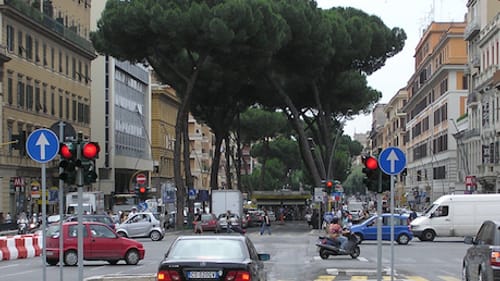Stay in the Loop
BSR publishes on a weekly schedule, with an email newsletter every Wednesday and Thursday morning. There’s no paywall, and subscribing is always free.
Impressions of Egypt and Italy
Philadelphia Orchestra presents 'The Pines of Rome'

This weekend, the Philadelphia Orchestra performed The Pines of Rome under principal guest conductor Stéphane Denève. The evening welcomed the promise of spring, offering what Keats called “a beaker full of the warm South… with beaded bubbles winking at the brim.”
Works by Berlioz, Saint-Saëns, and Connesson graced the program, but for my taste, Denève saved the best for last: Respighi’s sprawling impressionistic tone poem, which captured the show’s title.
Like a box of chocolates
Following a satisfying triad of works alluding to Mediterranean themes, The Pines of Rome seemed to welcome us to a higher order of experience engaging all the senses. Listening to this four-movement work was like having carte blanche to savor an entire display of chocolates, starting with the bitter darks, moving through the nougats and creams, and ending with meringues so divine they levitate right out of the box.
The work commands our attention with its agitated first movement, depicting children at play in the pine groves. And what children these must be! To me, it sounds like a traffic jam in the Via del Corso. So much better, though, to disassociate from the tensions of rush hour and instead enjoy the vigorous orchestral sounds slapping up against each other and dissolving in good-natured charm.
Pure music analysis has its merits, but there's a time and place to luxuriate in program music, and this was such a time. The second movement, titled “Pines Near a Catacomb,” unleashes daydreams of sweet-smelling pines and the cool mustiness of caves and abandoned abbeys.
Visions of moonlight and nightingales are summoned in the third section, “The Pines of the Janiculum,” tenderly leading to a final movement that builds in the style of Ravel’s Boléro. From whispered nothings, it rises to a vision of such scope and brilliance I looked over my shoulder to see if an additional brass section was playing in Tier 2 Center.

Thank you, Maestro Denève and orchestra, for your spectacular performance of this work, unsurpassed by any other I recall.
Into the woods
The preponderance of the program featured Berlioz’s fiery “Roman Carnival Overture,” off to a tentative start but picking up energy and focus along the way. Featured soloist Nicholas Angelich played Saint-Saëns’s Piano Concerto No. 5, the “Egyptian,” which included some delightful oboe passages elegantly played by Peter Smith. This is not my favorite concerto: it's a buffet of hummable melodies accompanied by an indulgent orchestra.
This performance was spirited and technically up to par, yet I felt the orchestra was holding back too much. The first movement’s disjointed variations (no fault of the performers) seem to lead nowhere, while the second movement, depicting a lazy houseboat cruise on the Nile, is like an opera where one endures the tedious recitatives in order to get to the tuneful arias.
The upper register of the Steinway sounded a bit like a toy piano a few minutes into the Andante, though this impression was short-lived. The final movement’s soaring melodies and splendid playing by the soloist delighted much of the audience but was not quite enough to redeem the concerto for this listener.
The program also featured the first Philadelphia Orchestra’s performances of Guillaume Connesson’s “E chiaro nella valle il fiume appare” (“And the River Shimmers in the Valley”). This is the second of three interrelated tone poems the composer created to honor France, Italy, and Germany. The French selection was performed by the orchestra in October 2017, the German earlier in April 2018.
Connesson’s work exemplifies contemporary Romanticism, opening with a shy melody carried by violins and violas and joined by trumpet. Other instruments then emerge like bashful creatures coming out of the woods. While lush, the composition does not avoid discord but manipulates it for its expressive power. Tingling effects of the xylophone, harps, and bells add to the richness of the orchestra in a short work that deserves to be heard and heard often.
What, When, Where
The Pines of Rome. Nicholas Angelich, piano, Stéphane Denève, conductor. Philadelphia Orchestra. Hector Berlioz, "Roman Carnival Overture," Op. 9; Camille Saint-Saëns, Piano Concerto No. 5 in F major, Op. 103 (“Egyptian”); Guillaume Connesson, "E chiaro nella valle il fiume appare"; and Ottorino Respighi, The Pines of Rome. April 26-28, 2018, at the Kimmel Center's Verizon Hall, 300 S. Broad Street, Philadelphia. (215) 893-1999 or philorch.org.
Sign up for our newsletter
All of the week's new articles, all in one place. Sign up for the free weekly BSR newsletters, and don't miss a conversation.

 Linda Holt
Linda Holt